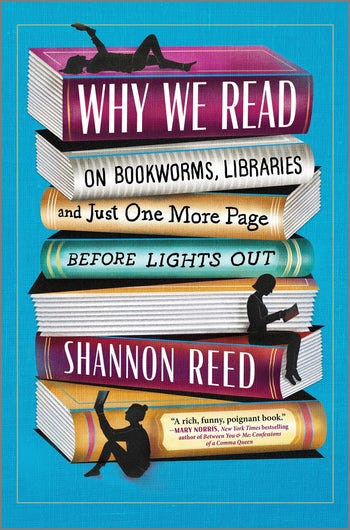Office Hours
"Why We Read" by Shannon Reed: an excerpt about teaching "Lincoln in the Bardo."
Hello all,
This week, a special treat: an exclusive excerpt from a new book being published by Hanover Square Press on February 6, called, Why We Read: On Bookworms, Libraries, and Just One More Page Before Lights Out, by Shannon Reed, a beloved and wonderful writer and professor living in Pittsburgh, Pennsylvania.
The excerpt is about teaching Lincoln in the Bardo to her students at Pitt. It’s a lovely, funny read, especially apropos for anybody who struggled with the book. And I know you’re out there! Shannon says, in the essay: “One of the methods I use to bring the fun back into teaching is to select a new-to-me novel and read it with the class.” She applied that method to “Lincoln…” and the result is a great example of what it means to trust your class - to assume the best of them and even, at times, to consent to be taught by them as well. I love the tone of Shannon’s writing - the implicit assumption that “of course, everything and anything can be discussed - that’s what language is for.” Hope you enjoy it too.
From her website, a little about Shannon:
“Shannon’s been published in The New Yorker, McSweeney’s Internet Tendency (where one of her pieces was the most-read article in 2018 and another was in the Top 3 this year), The Paris Review, The Washington Post, Slate, Buzzfeed, and many other venues. She is the Director of Undergraduate Studies and a Teaching Associate Professor in the Creative Writing Program at the University of Pittsburgh, where she teaches Introduction to Creative Writing, Introduction to Writing Fiction, Intermediate Fiction, Readings in Contemporary Fiction, Senior Seminar in Fiction, Readings in Contemporary European Novels, and Humor Writing, among others.”
“Her first book, Why Did I Get a B?: And Other Mysteries We’re Discussing in the Faculty Lounge, was released by Atria in hardback in June of 2020, and was a semi-finalist for the Thurber Prize in American Humor. She is also a fiction writer and playwright.”
Shannon says she’d love to hear from anyone with questions or comments. Feel free to comment here, of course, or (she says generously) email her at SReed151@gmail.com.
Thanks, Shannon, for applying your generous lens to my work (and opening the book up to your students).
You can pre-order Shannon’s book here, in which she applies this same articulate, funny voice to other aspects of the reading life.







It was a treat reading this excerpt from the Shannon Reed book, which I have now pre-ordered, and not only because of my surprise when she mentioned a book I had written. It was gratifying to read her acknowledgment of her own confusion and to follow the method by which she, and eventually her students, sorted it all —okay ,most of it—out. I suffered from the same confusion when I began reading L in the B. And (not being in a class with Shannon Reed, alas) when I mentioned that to a book-loving friend, she suggested that I try LISTENING to it. I have never been an audio-book fan. I started to say "for reasons I won't bore you with"... but actually the reason is perhaps interesting. I happen to have an eidetic memory. That means that when I look at a page of a book, I perceive it all at once, without actually reading the words. The first time I tried listening to a book, I lasted only short while and then groaned...to myself... Oh lord, he's not going to make me listen to every WORD, is he? And of course he was, and did, and I set the audio book aside impatiently and went back to the print version. But with L in the B in front of me, and annoyed with my own confusion, and heeding my friend's advice, I did indeed listen to it. Every word. And it magically became clear. I don't think this would work for Finnegan's Wake, but it sure worked for me with Lincoln in the Bardo.
I love how Shannon Reed captures the imbalance and confusion that sets in upon first reading L in the B. I was reminded of my own confusion when I first read the novel, which was heightened by the fact that the first few chapters were bound upside down into my copy of the book. It was literally a topsy turvy experience (a bardo experience?). I read part of it one way, then part of it the other way, while also trying to track the dialogue of those ghosts. To this day I wonder if the mis-binding was on purpose, part of George's grand plan to rattle the reader's assumptions about life and storytelling by having his publisher send out a certain amount of copies bound partially upside down....